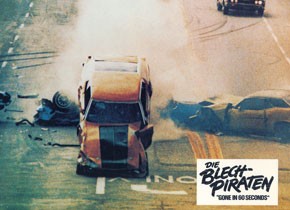Auto-Kino
Road | Movie: 1940-1976
August 27 to October 6, 2010
In its early decades, the cinematic gaze was strongly linked to the view from a train. Since the 1980s, (digital) cinema has increasingly adopted an “airborne” point of view, akin to a flight simulator. In between lies modern cinema, an era whose visual and narrative strategies were greatly influenced by a third mode of locomotion – the automobile and its relatives. Road movies from the 1940s to the 1970s reflected profound social changes in the wake of the global economic crisis and World War II. They also expressed the attendant cultural shifts: a more open and fluid relationship to time, space and identity. Being on the road always means: to be unstable, away from (the idea of) home, ready for encountering other ways of living. Leslie Dick: “On the road nobody knows you, you can be anybody, become anything.”
This first major Film Museum program following the summer break is dedicated to the intimate relationship between “automobility” and cinema. The selection of 50 features and shorts is framed by American car culture and a wider historical perspective on what is commonly called the genre of Road movies. Next year’s sequel to this series will mainly focus on the “nomadic” European films made since the late 1970s and on the postmodern Road movie. Part one, however, is centered on films from the U.S., especially from the “New Hollywood moment” of the late 1960s and early 1970s. Driving, drifting, fleeing and racing are the preferred modes of transportation in this era – from its breakout successes such as Bonnie and Clyde (1967) and Easy Rider (1969) through the modernist-existentialist narratives created by Barbara Loden (Wanda), Monte Hellman (Two-Lane Blacktop), Bob Rafelson (Five Easy Pieces), Daryl Duke (Payday) and Sam Peckinpah (Bring Me the Head of Alfredo Garcia) to the “cult films” obsessed by demolition and speed (Vanishing Point, Gone in 60 Seconds or Death Race 2000) It was often early on in the careers of major directors that they tried their luck on the road, or on the run: alongside Loden, Rafelson and Dennis Hopper, this is the case with Terrence Malick, Francis Ford Coppola, James William Guercio, H.B. Halicki, Steven Spielberg or George Lucas.
The “culture of change” that this new, post-classical generation of filmmakers laid claim to is often allegorized in a (rather vague) “quest for freedom” undertaken by their protagonists. Yet the settings chosen for these new Iliads and picaresque adventures were familiar: the road usually led into the vastness of the American continent. Road movies are thus often seen as an extension of the Western, not only due to the similar landscapes but also because of a shared skepticism towards modern civilization (“A man went looking for America and couldn’t find it anywhere”, as the tagline for Easy Rider has it). It may be no coincidence, then, that the earliest film in this program is by a director known for his Westerns: Like Stagecoach the year before, John Ford’s The Grapes of Wrath (1940) is very much a Road movie – and a strong record of the social upheavals that accompanied the dustbowl migration and the new forms of ‘social’ crime that marked the Great Depression.
The romantic-existential drive into wide open spaces and, at the same time, into the innermost recesses of the displaced subject is foreshadowed in various examples from film noir (Detour, They Live By Night, Gun Crazy) and in the confessional, autobiographical literature of Thomas Wolfe (You Can’t Go Home Again and A Western Journey, both published posthumously around 1940) and Jack Kerouac (On the Road, 1947-1957). “The hipster’s journey was the pleasure principle on wheels,” writes Manohla Dargis about Kerouac’s beat hero, Dean Moriarty. Around the same time, another Dean, given name: James, fell victim to his own “death drive on wheels.” Their modern form of masculinity is founded on speed and those fragmentary, fleeting images produced by the “visual apparatus” of man, car and windshield.
Even before it became fully acknowledged in cinema, this archetype manifested itself in television, for example in the widely discussed series Route 66 (1960-64). Thus, the oil and auto industries not only found willing accomplices in politics (U.S. Congress passed the Interstate Highway Act in 1956), but also established long-term “media partnerships” – for a product which in itself functioned as a mass medium. Baby boomers, raised on the declarations of independence that teen culture provided, were more than willing to adopt the corresponding consumer behavior, chauvinism included: “Get in this large, sexy car, drive fast; seduce women, gain freedom; be a hero whatever the odds.” (Mark Williams)
The retrospective highlights many other aspects of car culture – from hot-rod afficionados (Ingenuity in Action) through demolition derbies and stunt shows (Steel Arena) to the NASCAR circus (The Last American Hero). This culture is just as diverse and “impure” as the Road movie itself. More than a distinct genre, the term represents a “patchwork concept”, with several specific strands that are also included here, such as biker films, trucker and racing movies, and above all the “couple on the run” films. Nicholas Ray’s They Live By Night (1948) is the archetypical example, and Jean-Luc Godard’s Pierrot le fou (1965) delivered the definitive European response to the form.
Godard is part of a lineage without which the American Road movie of the 1960s and 1970s would not have been possible: the modernist European cinema, with its new conception of movement and time. From Antonioni to Bergman and Boorman, from Rossellini’s Viaggio in Italia (1954) to Matthias Weiss’ radically minimalist Blue Velvet (1970), a completely different kind of “Auto-Kino” opened up, one which, out of necessity, pursued an expanse located more in the film experience itself than in the landscape outside. As Dietrich Kuhlbrodt wrote about Blue Velvet, a film in which the notion of drama becomes fully suspended: “What’s important is only the state of mind: travelling. The film itself is on the move.”


